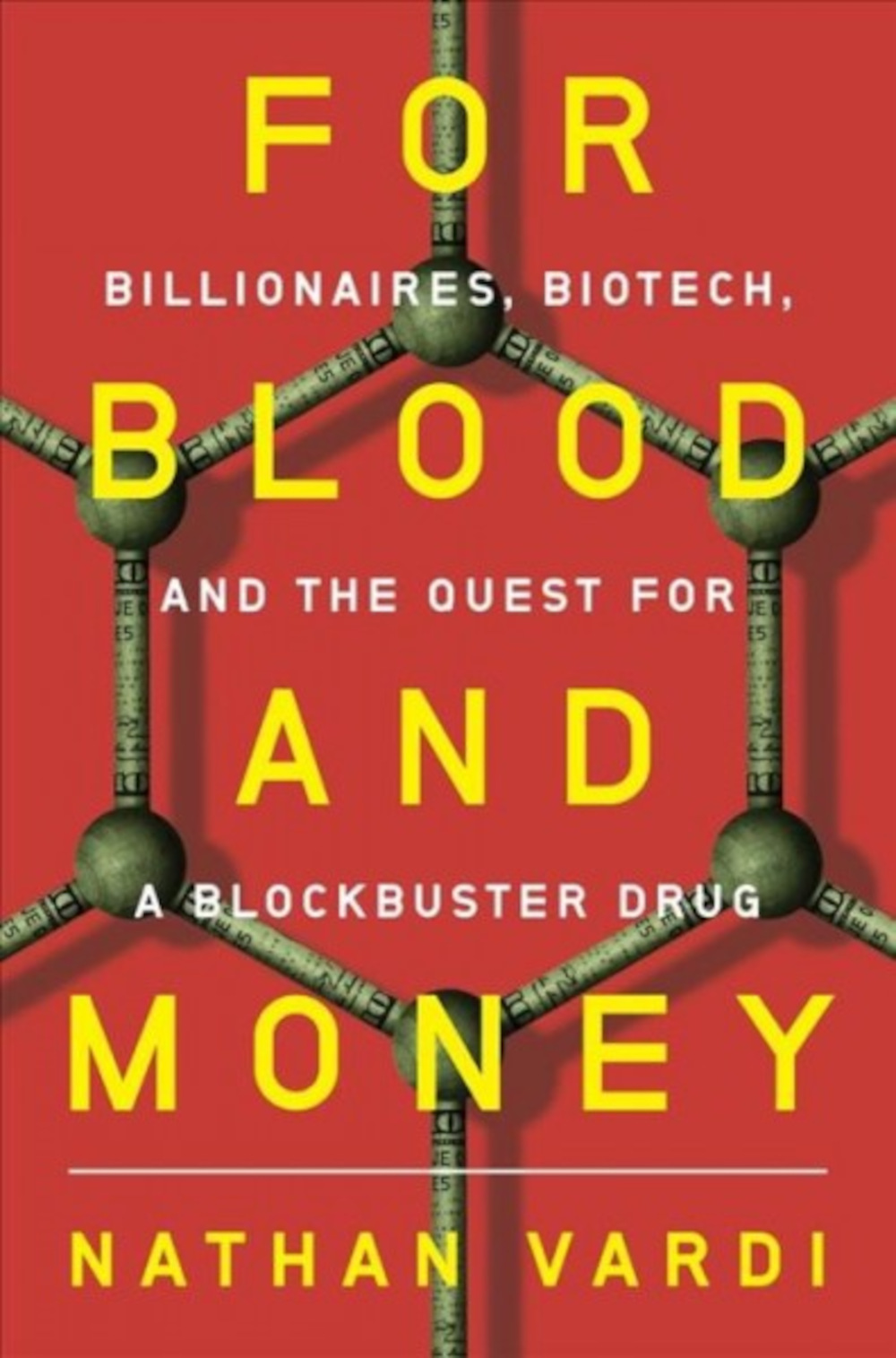In 2011, Ahmed Hamdy, a clinical researcher, sat in a parking lot in Sunnyvale, California. On his mind: a brand-new anti-cancer drug that, true to Silicon Valley parlance, seemed poised to change the world. Only Hamdy had just been fired as chief medical officer earlier that day from a startup named Pharmacyclics.
The scene of a dejected doctor, head in his proverbial hands, opens Nathan Vardi’s “For Blood and Money: Billionaires, Biotech, and the Quest for a Blockbuster Drug” and it’s the first sign that Vardi won’t just spin the story of a phenomenally successful business out to remake an entire industry as a thrilling triumph. Nor is it a morality tale featuring a scandalously overhyped business. Rather, Hamdy comes off as an earnest diplomat whose setback reflects the grim realities of the biotech revolution and how secretive investors can make — and unmake — lifesaving drugs.

BOOK REVIEW — “For Blood and Money: Billionaires, Biotech, and the Quest for a Blockbuster Drug,” by Nathan Vardi (W. W. Norton & Company, 288 pages).
Hamdy eventually goes on to co-found another company, Acerta Pharma, and the narrative is at its most propulsive as the two biotech startups race to develop two rival drugs now known as Imbruvica and Calquence. Both drugs inhibit the activity of an enzyme called Bruton’s tyrosine kinase, and these so-called BTK inhibitors indisputably revolutionized the treatment of mantle cell lymphoma and chronic lymphocytic leukemia.
The origin story of these blood cancer drugs will be unfamiliar to most readers, but, as Vardi has it, they’re part of the “hot new field of tyrosine kinase inhibitors.” So hot, in fact, that AbbVie eventually bought Pharmacyclics for $21 billion and AstraZeneca purchased a majority stake in Acerta Pharma in another multibillion dollar sale. These two deals, Vardi argues, represented the peak of the biotech boom and produced some “of the greatest Wall Street trades ever — in any industry.”
Initially, though, the compound that would later become Imbruvica amounted to little more than worthless crud, developed by a chemist at another company. It was then sold off, as part of a larger deal, at a “rock-bottom price.” In 2004, Robert Duggan, a former cookie salesman, Scientologist, and serial entrepreneur, began investing in Pharmacyclics, motivated by his son’s death from brain cancer. He eventually threatens to oust the company’s board, spurring the resignation of Pharmacyclics’ cofounder, a renowned Stanford scientist — all prelude to Hamdy’s departure and all sorts of drama. The conflict arrived in unexpected places, such as an oncology society’s dinner reception in Chicago that, in Vardi’s telling, devolved into literal arm-twisting and at least one F-bomb in a dispute over the drug’s therapeutic window.
Vardi takes us inside — to poster sessions, meeting rooms — and eventually he pans East, as Wayne Rothbaum, a New York stock trader turned jilted Pharmacyclics investor, funds a rival upstart, Acerta Pharma, where Hamdy and another key former Pharmacyclics employee work in California. It is literally the quintessential Silicon Valley startup run out of a garage.
Along the way, Vardi explains what was so unusual: For the first time, stock traders were directly funding private biotech, opening up “a spigot of money.” Vardi writes that Rothbaum, like Duggan, had no scientific background, yet the financier was versed in science and forcefully inserted himself in daily operations — strictly enforcing its stealth mode, keeping close tabs on patient data, and even securing a coveted byline on a study published in The New England Journal of Medicine.
Underlying the tale is a broader conflict between business and science: the desire to make money while also making an earnest effort to improve people’s lives. Vardi layers on the many interpersonal conflicts, getting Rothbaum to open up to a journalist for the first time; Duggan did not cooperate, aside from denying certain juicy details.
Vardi does his best to guide readers through this insular world in all its excruciatingly technical detail, translating BTK inhibitors and “participating preferred shares” into lay terms and spelling out the regulatory steps needed for new drug approval. That said, Vardi, a former reporter and editor at Forbes, does a better job of explaining science than unpacking financial nuance (e.g. Series A financing and annualized net return). It is a small, telling detail that he defines the Food and Drug Administration but not the Securities and Exchange Commission.
Perhaps in a painstaking effort to vernacularize the complex financial, legal, and scientific twists, Vardi packs his narrative with metaphors. Several involve baseball; many are familiar to the point of cliché. For instance, Pharmacyclics initially strikes out, failing to get one of its drugs approved three times, and then essentially “refused to leave the plate.” Later, when a clinical trial pits the two drugs directly against each other for the first time, and Acerta Pharma’s BTK inhibitor appears to be better, Vardi writes that AstraZeneca (which had by then acquired Acerta) hit “a home run, if not a grand slam.”
“For Blood and Money” superficially resembles those formulaic airport biz-books where some heroic outsider wins big with a previously unknown play. Duggan, after all, is a father grieving his son’s death who prevails through pluck and persistence. “People were cast aside in the process, dreams broken, strategies co-opted, and companies overtaken,” Vardi writes. “But it was undeniable that Duggan had done the unimaginable and produced something that was saving lives.”
Lymph nodes shrink. Cancer patients get their lives back. And in the end, two drugs that may never become household names mint a lot of money for investors. But Vardi goes a step further, parading out a litany of “forgotten scientists” (including the chemist who created the compound that became the first successful BTK inhibitor) and the roster of “people who had revolutionized the treatment of chronic lymphocytic leukemia with BTK inhibitors.”
The high-resolution view of so many particulars involved in such a specific subclass of drugs can make the overarching analysis a shade too subtle. If nothing else, Vardi’s account puts some bite into the old saw about developing drugs: “The first disaster is if you kill people,” Alex Hittle, a biotech analyst, told a journalist nearly 20 years ago. “The second disaster is if you cure them.” Cures, after all, eliminate customers, a problem especially in a niche market already constrained by the relative rarity of a disease, and with chronic medications that can cost upwards of $10,000 a month and can be taken for the duration of a patient’s life. (Vardi quotes Duggan as saying, “What it doesn’t have in terms of quantity of patients, it makes up for in terms of years of therapy.”) Rather than painting this as a vast conspiracy, though, Vardi is simply showing, up close and personal, how the game is played. This is how capitalism works.
In the ensuing years, the financial appetite for biotech stocks cooled, suggesting these two exceptional companies were one-offs at the peak of a bull market. But, Vardi implicitly raises other questions: Are they also representative of the role small-scale startups play in the global pharmaceutical industry? And are such startups really helping medical progress?
In one of his strongest takeaways, Vardi describes how physician-scientists who worked in the trenches, filling out paperwork, recruiting patients, and administering these once-experimental drugs ultimately felt shortchanged by the corporate megadeals. As for the team at Acerta Pharma, “They felt cheated, that they deserved more and had done more and that the fat cats were taking home an outsized portion of the wins created by what they had done,” he writes. “These feelings were confusing but tied to the harsh reality of the biotechnology revolution. Even in cancer drug development, most of the financial gains often went to capital and not to labor.”
Peter Andrey Smith is a freelance reporter. His stories have been featured in Science, STAT, The New York Times, and WNYC Radiolab.











Comments are automatically closed one year after article publication. Archived comments are below.
A similar but more impactful story is that of T2 Biosystems and the blood culture industry. T2 biotechnology identifies, direct from blood, bloodstream pathogens that cause sepsis. It takes 3-5 hours. It identified the appropriate antibiotics. Blood cultures take days and have poor accuracy. Sepsis causes more deaths and amputations than cancer. T2 technology is Nobel-Prize-worthy. But its stock price is manipulated mercilessly in an effort to squelch the technology.